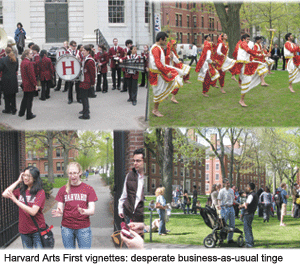 The sub-prime mortgage crisis, spate of scandals on Wall Street and America’s great economic meltdown, which has triggered a global recession perhaps the worst since the Great Depression of 1929-33, hasn’t visibly impacted the tree-lined, green squared 4,947-acre campuses of Harvard University which sprawl across the town of Boston and Cambridge on the eastern seaboard of the United States. On April 30, the 20,000 students of America’s showpiece university — and the world’s most admired institution of higher education according to almost every comparative league table in the US and abroad — staged its annual four-day, spring-time Arts First festival of non-stop dance (bhangra included), drama, music (including a Carnatic music rendition), films, public art, and a plethora of art and sculpture exhibitions, as usual.
The sub-prime mortgage crisis, spate of scandals on Wall Street and America’s great economic meltdown, which has triggered a global recession perhaps the worst since the Great Depression of 1929-33, hasn’t visibly impacted the tree-lined, green squared 4,947-acre campuses of Harvard University which sprawl across the town of Boston and Cambridge on the eastern seaboard of the United States. On April 30, the 20,000 students of America’s showpiece university — and the world’s most admired institution of higher education according to almost every comparative league table in the US and abroad — staged its annual four-day, spring-time Arts First festival of non-stop dance (bhangra included), drama, music (including a Carnatic music rendition), films, public art, and a plethora of art and sculpture exhibitions, as usual.
Yet even as earnest fresh-faced undergrads of Harvard College — structurally Harvard University comprises an undergrad college with 6,700 students enroled in its four-year liberal arts and science study programmes and ten postgrad business, divinity, medicine etc schools with an aggregate student enrolment of 12,300 — dutifully enunciated their monologues and enacted street plays under grey skies before charmed tourist groups from around the world drawn by the Harvard mystique, there was a discernible touch of desperation, a determined business-as-usual tinge to this ancient (estb.1636) academic institution’s Arts First 2009 festival.
Subterraneously, the stormy waters washing over America have crept beneath the ramparts of this vintage and much-venerated institution of higher learning, damaging its foundations. Harvard University’s fabled endowment corpus, painstakingly accumulated over the past almost four centuries and which once upon a time was valued at $40 billion (Rs.200,000 crore) making it the second largest institutional endowment corpus in the world after that of the Church of Rome, has suffered continuous value erosion following the stock market meltdown on Wall Street and is currently valued at a mere $28 billion (Rs.140,000 crore).
When your correspondent visited Harvard last month (May), anxiety and fear of the future was discernible in the body language and demeanour of administrators and staff in the ten-storey Holyoke Center off Harvard Square, which houses the top brass of the university including the sanctified executive suite of Dr. Drew Gilpin Faust, the reputedly formidable first woman president of this 393-year-old seat of advanced learning. Or reports buzzing within the Holyoke that two students of the wholly residential Harvard College were infected with the swine flu virus could have been the cause.
Nevertheless the weight of evidence indicates that the great financial crises which have engulfed the US, and could well result in the market value of Harvard’s endowment corpus plunging by 30 percent by the end of the current fiscal on June 30 to $24.5 billion (Rs.123,000 crore), have shaken President Faust, as she is referred to in Harvard. None of her minions were able to persuade her to either meet with your correspondent or respond to a ques-tionnaire submitted to her office a month ago at the request of John Longbrake, senior director of communications at the university.
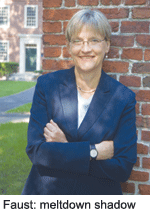 According to Harvard rumour mills, Faust, who owes her surprise elevation to the top job at Harvard to a huge backlash generated by her predecessor Dr. Lawrence Summer’s off-the-cuff speculations about the innate aptitude of women for high-end maths and science, than to her own academic track record, is reportedly unnerved by the dramatic meltdown of Harvard’s much-envied endowment corpus. When Faust took charge as the first woman president of this high-profile university on July 1, 2007, the corpus was valued at $40 billion. Since then, the unrelenting meltdown of Harvard’s corpus fund has cast a long shadow over her presidency, and has eclipsed her commendable feat of attracting the university’s largest ever single endow-ment of $125 million (Rs.625 crore) from Swiss billionaire Hansjorg Wyss to establish an eponymous multi-disci-plinary institute for nanotechnology development, stem cell research and molecular biology at Harvard Medical School.
According to Harvard rumour mills, Faust, who owes her surprise elevation to the top job at Harvard to a huge backlash generated by her predecessor Dr. Lawrence Summer’s off-the-cuff speculations about the innate aptitude of women for high-end maths and science, than to her own academic track record, is reportedly unnerved by the dramatic meltdown of Harvard’s much-envied endowment corpus. When Faust took charge as the first woman president of this high-profile university on July 1, 2007, the corpus was valued at $40 billion. Since then, the unrelenting meltdown of Harvard’s corpus fund has cast a long shadow over her presidency, and has eclipsed her commendable feat of attracting the university’s largest ever single endow-ment of $125 million (Rs.625 crore) from Swiss billionaire Hansjorg Wyss to establish an eponymous multi-disci-plinary institute for nanotechnology development, stem cell research and molecular biology at Harvard Medical School.
Yet despite the world’s most respected (and richest) college being bruised by the crash of equity prices on Wall Street, where most of its corpus was erroneously believed to have been parked in safe stocks and bonds, within this vintage university’s campuses and brownstone student halls of residence (where 96 percent of the varsity’s undergrads live), the search for academic excellence continues as usual. With effect from this academic year beginning September, Harvard’s strong liberal education tradition is being reinforced with the replacement of its 30-year-old Core Curriculum — mandatory for all freshmen or first year students — with a carefully conceptualised General Education curriculum designed by a high-powered ten-strong committee chaired by Prof. Jay M. Harris, Wolfson professor of Jewish Studies in the faculty of arts and science (FAS, which includes Harvard College), after labouring for several years to finalise it.
Designed on the premise that “a Harvard education is a liberal education — that is, an education conducted in free spirit of enquiry undertaken without concern for topical relevance or vocational utility”, the new general education curriculum offers undergraduate students wider horizons and greater choice. Like its predecessor Core Curriculum, the Gen Ed curriculum also ensures that all Harvard students receive a good grounding in the study of the liberal arts and humanities before branching out into their chosen streams and concentrations.
From the new academic year starting September 2009, every undergrad student will have to take a one half course (i.e pass one exam per semester) in each of eight categories — aesthetic and interpretive understanding; culture and belief; empirical reasoning; ethical reasoning; science of living systems; science of the physical universe; societies of the world, and the United States in the world. Comments the report of the committee on the rationale behind the switch to the new Gen Ed curriculum: “The world has changed since the last time the faculty instituted a general education curriculum. So has the state of knowledge, and so has Harvard. We think that a general education curriculum needs to take these changes into account.”
While the structure and content of the new general education curriculum has generated considerable controversy with some critics labelling it old wine in a new bottle, and others lamenting its failure to recommend a Great Books reading list, the institutional objective is to ensure that all Harvard College students receive a broad, more contemporary education even as they focus on their electives and concentrations. This awareness of the value of liberal arts education avoids the pitfall so common in Indian higher education — premature streaming into concentrations and utilitarian professional and vocational education. The outcome of early specialisation is the injection of an estimated 2.75 million narrowly specialised, amoral professionals and ‘techies’, untrained in citizenship and innocent of their societal obligations, into Indian industry and the professions annually.
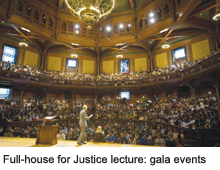 On the other hand, harvard (and most American) academics believe a broad foundational liberal arts education is a necessary precondition of their students developing into well-rounded and knowledgeable citizens. Therefore they take pains to avoid premature specialisation, the bane of Indian (and British) education. That’s why the duration of a Harvard undergraduate degree programme is four years against three years in India and the UK.
On the other hand, harvard (and most American) academics believe a broad foundational liberal arts education is a necessary precondition of their students developing into well-rounded and knowledgeable citizens. Therefore they take pains to avoid premature specialisation, the bane of Indian (and British) education. That’s why the duration of a Harvard undergraduate degree programme is four years against three years in India and the UK.
The high respect that the Harvard faculty and student body have for liberal arts education is reflected in the iconic status that several FAS professors such as H.T. Kung, Leah Price, and Robert Barro enjoy in this carefully nurtured university. Their lectures delivered in the largest halls and amphitheatres of Harvard are filled to the rafters with eager undergraduate and postgrad students keen to acquire insights into larger issues beyond the concentrations and prescribed curricula.
Among the most popular of Harvard’s iconic faculty is Dr. Michael J. Sandel, Bass professor of government at the John F. Kennedy School of Government, who offers a philosophic lectures programme on the concept and subject of Justice, which set a Harvard record of highest enrolment of 1,115 students in 2007. Over the years, Sandel’s Socratic-style lectures have become gala events with students keen to engage in question and answer jousts in the pursuit of mind-expanding knowledge and insights.
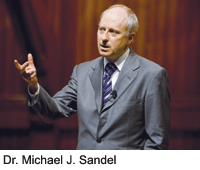 “In Harvard the faculty is unanimous that it’s vital to encourage students to think critically and engage in discussing and debating what may seem to be abstract philosophic concepts and issues. To teach students to think and develop their own arguments and points of view, rather than accept what’s handed down to them from on high, is a distinguishing characteristic of education at Harvard. We also believe that foundational liberal education is of crucial importance as it equips our students to live meaningful lives as contributing citizens of their countries and societies,” says Sandel, an alumnus of Oxford University (UK) who signed up with Harvard as an assistant professor in 1980, and is currently finalising a plan to upload his justice lectures on the internet to “share them with the world”.
“In Harvard the faculty is unanimous that it’s vital to encourage students to think critically and engage in discussing and debating what may seem to be abstract philosophic concepts and issues. To teach students to think and develop their own arguments and points of view, rather than accept what’s handed down to them from on high, is a distinguishing characteristic of education at Harvard. We also believe that foundational liberal education is of crucial importance as it equips our students to live meaningful lives as contributing citizens of their countries and societies,” says Sandel, an alumnus of Oxford University (UK) who signed up with Harvard as an assistant professor in 1980, and is currently finalising a plan to upload his justice lectures on the internet to “share them with the world”.
Harvard’s institutional commitment to encouraging the spirit of enquiry with the objective of creating new knowledge, which allows departmental faculty to design their own curriculums and pedagogies, is also extended to research. In Harvard — as in other front-ranked universities in the US — there is complete unanimity that the worth and calibre of a university is dependent upon its research output and in particular, the number of citations received and/or research papers published by faculty in respectable research journals. Therefore Harvard faculty engaged in research are granted as much latitude, freedom and institutional resources as are the university’s star professors.
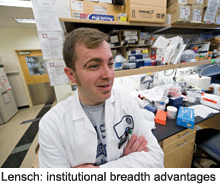 “With so many Nobel prize winners in various disciplines having conducted their research studies at Harvard, this university has acquired a reputation for big science and research projects. Moreover it is pertinent to bear in mind that Harvard University is a very broad institution with its several schools offering high quality graduate education in several disciplines. This breadth of operations facilitates researchers from our various schools drawing upon the diversity of faculty within Harvard to work together on large-scale projects to create new breakthrough knowledge,” explains Dr. M. William Lensch, instructor of paediatric research at the globally famous Harvard Medical School, and currently engaged in stem cell research of momentous implications.
“With so many Nobel prize winners in various disciplines having conducted their research studies at Harvard, this university has acquired a reputation for big science and research projects. Moreover it is pertinent to bear in mind that Harvard University is a very broad institution with its several schools offering high quality graduate education in several disciplines. This breadth of operations facilitates researchers from our various schools drawing upon the diversity of faculty within Harvard to work together on large-scale projects to create new breakthrough knowledge,” explains Dr. M. William Lensch, instructor of paediatric research at the globally famous Harvard Medical School, and currently engaged in stem cell research of momentous implications.
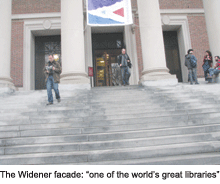 Carefully conceptualised and well-designed curriculums taught by handsomely remunerated academics — the annual salary of a tenured Harvard professor is $180,000 (Rs.90 lakh) cf. the American average of $60,000-70,000 — are supplemented by superb campuses bristling with enabling infrastructure, much envied around the world, and in particular by tertiary education students in developing countries, dependent on pathetically meagre budgetary provisions that wasteful governments make for higher education. The varsity’s 62 fully-wired and technology enabled classrooms, 49 lecture halls, 254 seminar rooms and numerous state-of-the-art science and technology labs are capped by the mammoth 300,000 sq.ft Widener library in Harvard Square, which houses 3 million volumes, and offers a seating capacity of several thousand.
Carefully conceptualised and well-designed curriculums taught by handsomely remunerated academics — the annual salary of a tenured Harvard professor is $180,000 (Rs.90 lakh) cf. the American average of $60,000-70,000 — are supplemented by superb campuses bristling with enabling infrastructure, much envied around the world, and in particular by tertiary education students in developing countries, dependent on pathetically meagre budgetary provisions that wasteful governments make for higher education. The varsity’s 62 fully-wired and technology enabled classrooms, 49 lecture halls, 254 seminar rooms and numerous state-of-the-art science and technology labs are capped by the mammoth 300,000 sq.ft Widener library in Harvard Square, which houses 3 million volumes, and offers a seating capacity of several thousand.
“Eleanor Elkins Widener had the library constructed in 1915 in memory of her son Harry Elkin Widener who perished aboard the Titanic and was an enthusiastic book collector. The Widener is now one of the world’s great libraries, comparable with the Bodleian, the British Library or Bibliotheque National. Originally constructed by one of America’s first African-American architects Julian Abeles… it offers extraordinarily plush reading rooms, full of natural light,” wrote Pratap Bhanu Mehta, a Harvard (and Princeton) alumnus and currently director of the Centre for Policy Research, Delhi in EducationWorld (May 2004).
 This superb enabling infrastructure comes at a heavy price which the university’s management is ready, willing and able to pay. According to G. Joseph Wrinn, the knowledgeable director of university communications at Harvard, the annual budget of the varsity is a humungous $3 billion (Rs.15,000 crore) “funded by interest flowing from the endowment corpus, tuition fees, and institutional fund raising”.
This superb enabling infrastructure comes at a heavy price which the university’s management is ready, willing and able to pay. According to G. Joseph Wrinn, the knowledgeable director of university communications at Harvard, the annual budget of the varsity is a humungous $3 billion (Rs.15,000 crore) “funded by interest flowing from the endowment corpus, tuition fees, and institutional fund raising”.
Little wonder Indian students intelligent enough to beat the country’s teacher-centric, memorisation-oriented education system to qualify for admission into this academically demanding institution, are zapped by the Harvard experience.
Comments Ritambhara Kumar a senior (final year) economics concentrator at Harvard College who schooled in Mumbai’s Villa Theresa high school and DPS, R.K. Puram, Delhi prior to being admitted into Harvard in 2005: “The learning experience here has been one of consistent, exponential growth. I’ve been exposed to cutting-edge research and ideas in economics and have had the opportunity to take classes in diverse fields of study including film, literature, foreign languages and philosophy. My learning experience has been more holistic and well-rounded compared to my learning experiences in India. The important difference however is that in Harvard we are constantly encouraged to question received wisdom and critique well-established ideas in stark contrast to my experience in India where I was frequently asked to memorise and reproduce answers without any critical input.”
Moreover from the perspective of Indian, and sub-continental readers who constitute the prime target audience of EducationWorld, it is pertinent to note that Harvard University’s substan-tially successful search for academic excellence has been attained without any government assistance or supervision. Unlike institutions of higher education (public and private) in India, which are subject to the direction and supervision of several organisations including the University Grants Commission, All India Council for Technical Education and their subsidiaries NAAC (National Assessment & Accreditation Council) and NAB (National Accreditation Board), which licence and approve their study programmes, and the education departments of state governments and the Union government’s HRD ministry which regulate admission and fees, Harvard University is an entirely autonomous academic institution. Its syllabuses and curriculums are concept-ualised and designed by its own faculty, without any study programmes having to be approved by external organisations, or administrative processes subject to government supervision.
The sole seal of approval Harvard’s trustees and board of governors are obliged to obtain is of the global marketplace in which industry, government and social sector employers are ready to pay high premia for this pioneer and exemplary university’s alums. The idea of Harvard University having to get government ‘recognition’ — a vitally important word in the Indian academic lexicon — or approval for any of its study programmes or administrative policies, is inconceivable and abhorrent to the varsity’s faculty and administrators. Indeed Harvard and America’s other great universities are live and model examples of the virtues of academic autonomy, from which 21st century India’s busybody, interfering and purblind educrats could derive many valuable lessons.
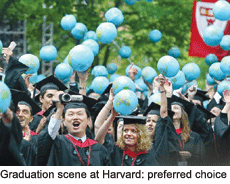 Against this backdrop of Harvard having established itself as a wholly autonomous institution of higher education offering excellent curriculums, committed and brilliant faculty, and superb academic infrastructure, and with the varsity routinely topping the global university league tables, it’s hardly surprising that Harvard is the most preferred choice of the brightest and best students from across the US and around the world. Moreover to this combination of qualities which enthuse scholars and intellectuals worldwide, add the opportunity to study and interact 24x7 with the brightest and best students from around the world (96 percent of Harvard College students reside on its closely knit campuses), and the university’s unique ‘need-blind’ admission policy.
Against this backdrop of Harvard having established itself as a wholly autonomous institution of higher education offering excellent curriculums, committed and brilliant faculty, and superb academic infrastructure, and with the varsity routinely topping the global university league tables, it’s hardly surprising that Harvard is the most preferred choice of the brightest and best students from across the US and around the world. Moreover to this combination of qualities which enthuse scholars and intellectuals worldwide, add the opportunity to study and interact 24x7 with the brightest and best students from around the world (96 percent of Harvard College students reside on its closely knit campuses), and the university’s unique ‘need-blind’ admission policy.
By the standards of India’s government owned and subsidised 21,000 colleges and 431 universities, where under a curious and perverse regime of indiscriminate subsidisation well-off, middle class students who dominate student bodies pay barely 5 percent of the actual cost of their tuition, Harvard’s tuition fees are dizzily high. For instance the listed annual tuition-cum-room and board fee payable by liberal arts and science undergrad students is a chastening $48,868 (Rs.24.4 lakh) per year. Yet the university’s unique ‘need-blind’ admission policy — underwritten by Harvard’s massive endowment corpus — subsidises the tuition and residential expenses of 75 percent of students admitted into the world’s most respected university.
“More than three-fourths of Harvard’s 6,600 undergraduate students receive some financial aid and/or scholarships to enable them to study here. For several centuries it has been official policy of this university that meritorious and committed students from around the world who meet our rigorous admission standards should not be disqualified because they don’t have the means to pay their tuition and living expenses at Harvard. Under the university’s need-blind admission policy every student is free to apply for financial aid and his/her family is means tested for ability to afford tuition. On the basis of our assessment of ability to pay, students are offered financial aid packages comprising scholarships, loans and ‘happy jobs’ such as writing for our journals, bar-tending etc to cover their tuition and living expenses. Moreover, it is pertinent to note that in recent years our financial aid packages have become more generous and that under our new Harvard Financial Aid Initiative of 2004, students whose family income is below $80,000 per year are not charged any fees at all,” says Dr. Robin Worth, an education alumna of Harvard’s John F. Kennedy School of Government, and currently the university’s director of international admissions.
Therefore unsurprisingly, the demand for admission into the college and graduate schools of this premier university by far exceeds capacity available. For the academic year 2006-07, 22,796 admission applications were received from around the world. Against this 1,648 students were admitted. The demand for admissions into its ten postgrad schools where admission criteria are even more rigorous, is as insistent. For instance Harvard Law School receives 7,200 applications for every vacancy; and Harvard Business School 7,000-10,000 for every student it admits.
Yet the mighty engine which drives the monumental, higher education juggernaut that is Harvard University, is the institution’s funds-raising or development division. Although the division itself headed by its hard-driving (and inaccessible) vice president Tamara Rogers, is compact, the Harvard reality is that it follows the example of the famous American computer hardware manufacturing behemoth IBM Inc: everyone of this great university’s 1,900-strong faculty is a salesperson for Harvard.
In this connection it is important to bear in mind that the varsity’s still massive endowment corpus is an agglomeration of 10,800 gifts, individual and collective donations, bequests, and scholarship grants. In sharp contrast with Indian academics who tend to be shy about being involved with institutional commercial activity, it is arguable that at bottom, Harvard University is among many of America’s great commercial enterprises with everything from professorial chairs, the Harvard brand and logo, libraries, laboratories, dormitories and entire buildings, subject to marketing. Thus some of Harvard’s most enduring monuments starting with the Widener library to the university’s myriad professorial chairs and postgraduate schools are standing testimony to the fund-raising capabilities of this great institution. Even the Harvard brand name and logos are strongly marketed with the university quick to issue legal notices for unauthorised use.
Unlike contemporary India which has yet to recover from its socialist hangover, and where “commercial-isation of education” is strongly disapproved by the Central and state governments and even the newly-liberal Supreme Court, unambiguously persuaded that its institutional mission is to provide best quality, need-blind higher education to all students who qualify for admission, Harvard’s management and faculty are unapologetic about commercialising the university’s brand and image carefully built over the past four centuries. And this great institution’s massive corpus, excellent faculty and infrastructure, and its need-blind admission policy are proof that enlightened commercialisation of education works in the public interest.
Yet despite ex facie life and academic routines going on as usual in Harvard Square, Harvard College and the ten research-intensive and new knowledge creating postgraduate schools, there’s no doubt that the financial crises of Wall Street and America’s great economic meltdown have shaken the foundations of the world’s most respected university. Even as alarming reports of diminution of the value of Harvard’s much-envied endowment corpus (traditionally 4.5 percent of the return on the endowment is allocated for operations) continue to pour into Holyoke Center, the university’s management has responded. Salaries have been frozen; a voluntary early retirement scheme for 1,600 staff has been announced; construction work on the university’s new $1 billion (Rs.5,000 crore) Allston campus has been slowed, and tuition fees have been raised by 3.5 percent to a chastening $48,868 (Rs.24.4 lakh) per year at Harvard College and commensurately in its postgrad schools. The number of staff and faculty meetings has multiplied exponentially and top management has gone into laager formation.
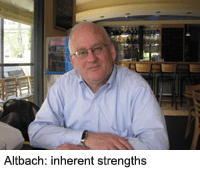 Nevertheless knowledgeable monitors of the higher education scene in the US are confident this great university will ride out the current recessionary storm, just as it did America’s Great Depression of 1929-33 with aplomb. “Harvard University has many strengths and great resilience which will enable it to emerge from its current sea of troubles. For one, despite its endowment corpus suffering considerable erosion, Harvard is still the world’s richest university. Moreover it is an unremitting meritocracy with a long historical tradition of academic and management excellence. These inherent strengths built up over the centuries will enable the university to navigate its way out of its current sea of troubles as it has so often done in the past,” says the Boston-based Philip G. Altbach, director of the Center for International Higher Education at Boston College and a well-known expert on comparative international education.
Nevertheless knowledgeable monitors of the higher education scene in the US are confident this great university will ride out the current recessionary storm, just as it did America’s Great Depression of 1929-33 with aplomb. “Harvard University has many strengths and great resilience which will enable it to emerge from its current sea of troubles. For one, despite its endowment corpus suffering considerable erosion, Harvard is still the world’s richest university. Moreover it is an unremitting meritocracy with a long historical tradition of academic and management excellence. These inherent strengths built up over the centuries will enable the university to navigate its way out of its current sea of troubles as it has so often done in the past,” says the Boston-based Philip G. Altbach, director of the Center for International Higher Education at Boston College and a well-known expert on comparative international education.
Undoubtedly the combination of positive qualities — academic innovation, pursuit of scholastic excellence and creation of new knowledge, ability to attract the world’s brightest and best academics, students and not least its unmatched institutional fund-raising capabilities — which have enabled this 393-year-old institution of advanced learning to produce a legion leaders, thinkers and economists who have consistently resolved much larger global problems, will enable the world’s most respected university to batten the hatches and navigate its way out of its current sea of troubles. Indeed, it’s more than likely that the design of a blueprint, which will insulate it from Wall Street volatility and place the varsity’s finances on a more even keel, will emerge from the in-house think tanks and powerhouses of research which have won Harvard global encomiums.
With Debolina Sengupta & Paige Aarhus (Bangalore)